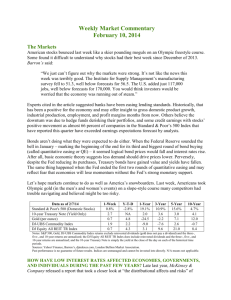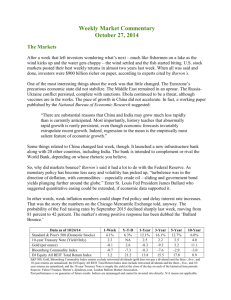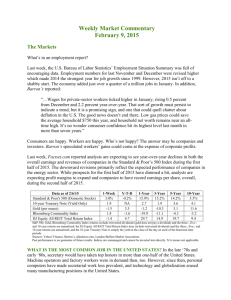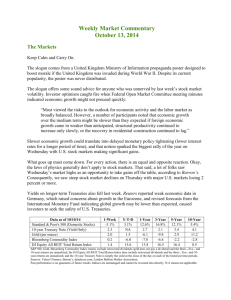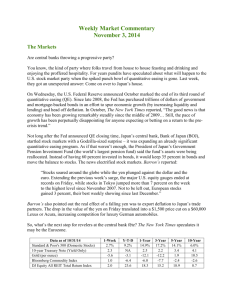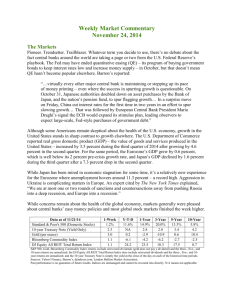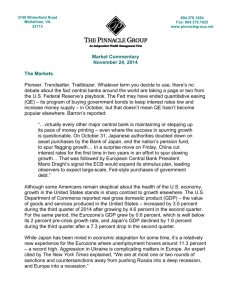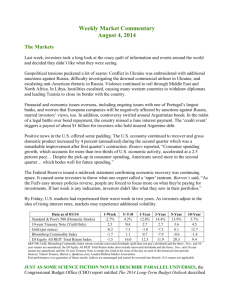Weekly Commentary 03-24-14 PAA
advertisement
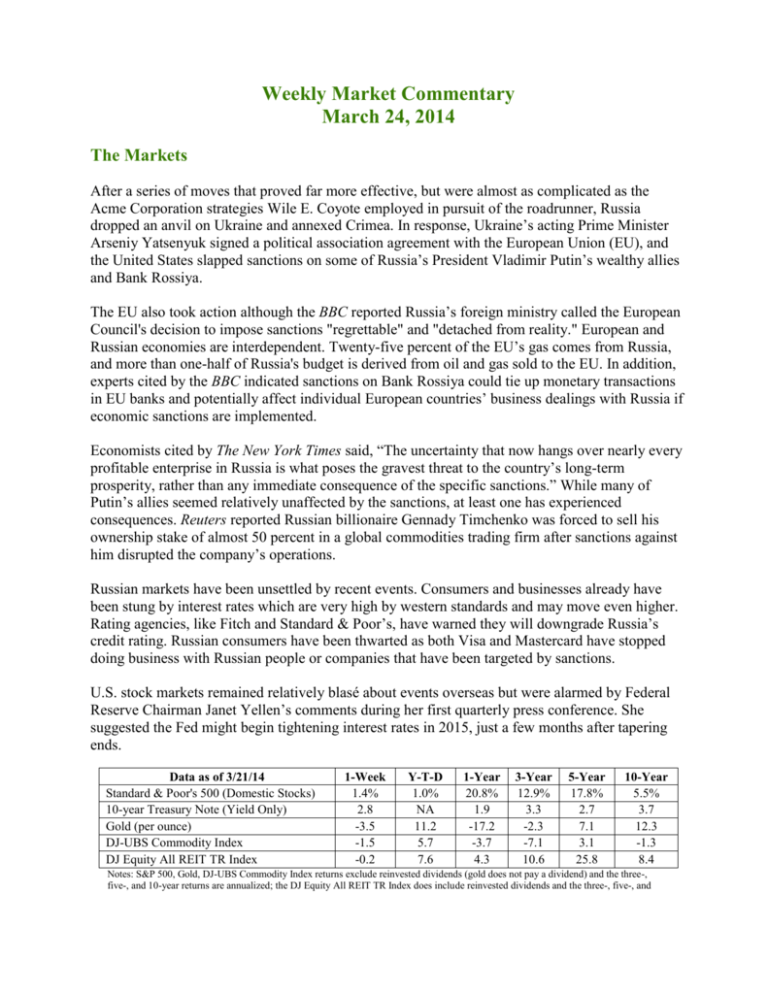
Weekly Market Commentary March 24, 2014 The Markets After a series of moves that proved far more effective, but were almost as complicated as the Acme Corporation strategies Wile E. Coyote employed in pursuit of the roadrunner, Russia dropped an anvil on Ukraine and annexed Crimea. In response, Ukraine’s acting Prime Minister Arseniy Yatsenyuk signed a political association agreement with the European Union (EU), and the United States slapped sanctions on some of Russia’s President Vladimir Putin’s wealthy allies and Bank Rossiya. The EU also took action although the BBC reported Russia’s foreign ministry called the European Council's decision to impose sanctions "regrettable" and "detached from reality." European and Russian economies are interdependent. Twenty-five percent of the EU’s gas comes from Russia, and more than one-half of Russia's budget is derived from oil and gas sold to the EU. In addition, experts cited by the BBC indicated sanctions on Bank Rossiya could tie up monetary transactions in EU banks and potentially affect individual European countries’ business dealings with Russia if economic sanctions are implemented. Economists cited by The New York Times said, “The uncertainty that now hangs over nearly every profitable enterprise in Russia is what poses the gravest threat to the country’s long-term prosperity, rather than any immediate consequence of the specific sanctions.” While many of Putin’s allies seemed relatively unaffected by the sanctions, at least one has experienced consequences. Reuters reported Russian billionaire Gennady Timchenko was forced to sell his ownership stake of almost 50 percent in a global commodities trading firm after sanctions against him disrupted the company’s operations. Russian markets have been unsettled by recent events. Consumers and businesses already have been stung by interest rates which are very high by western standards and may move even higher. Rating agencies, like Fitch and Standard & Poor’s, have warned they will downgrade Russia’s credit rating. Russian consumers have been thwarted as both Visa and Mastercard have stopped doing business with Russian people or companies that have been targeted by sanctions. U.S. stock markets remained relatively blasé about events overseas but were alarmed by Federal Reserve Chairman Janet Yellen’s comments during her first quarterly press conference. She suggested the Fed might begin tightening interest rates in 2015, just a few months after tapering ends. Data as of 3/21/14 Standard & Poor's 500 (Domestic Stocks) 10-year Treasury Note (Yield Only) Gold (per ounce) DJ-UBS Commodity Index DJ Equity All REIT TR Index 1-Week 1.4% 2.8 -3.5 -1.5 -0.2 Y-T-D 1.0% NA 11.2 5.7 7.6 1-Year 20.8% 1.9 -17.2 -3.7 4.3 3-Year 12.9% 3.3 -2.3 -7.1 10.6 5-Year 17.8% 2.7 7.1 3.1 25.8 10-Year 5.5% 3.7 12.3 -1.3 8.4 Notes: S&P 500, Gold, DJ-UBS Commodity Index returns exclude reinvested dividends (gold does not pay a dividend) and the three-, five-, and 10-year returns are annualized; the DJ Equity All REIT TR Index does include reinvested dividends and the three-, five-, and 10-year returns are annualized; and the 10-year Treasury Note is simply the yield at the close of the day on each of the historical time periods. Sources: Yahoo! Finance, Barron’s, djindexes.com, London Bullion Market Association. Past performance is no guarantee of future results. Indices are unmanaged and cannot be invested into directly. N/A means not applicable. SOME WORRY THE U.S. STOCK MARKET, LIKE A FIRST TIME MARATHONER a few miles from the finish, may be getting a little wobbly. There is no denying the Standard & Poor’s 500 Index has had a good run. It has gained about 172 percent since its low following the financial crisis, and its earnings have grown by 121 percent since 2008, according to Barron’s. Of course, that growth has been supported by extraordinary measures including very low interest rates and multiple rounds of quantitative easing. Low interest rates have meant businesses could borrow money relatively cheaply. Barron’s pointed out lower borrowing costs were reflected in bond spreads – the difference between the current yield on one type of bonds (for example, high-yield bonds, investment-grade bonds, or government bonds) and that of other types of bonds with similar maturities. The differences in yield between higher risk and lower risk bonds are a lot smaller than they once were. According to Barron’s, from late 2008 through early 2014, the yield on high-yield bonds and comparable Treasury bonds has narrowed from about 22 percent to about 4 percent. As private borrowing costs have dropped, companies have been able to borrow billions of dollars and pay relatively little in interest. Some have returned the money to shareholders as dividends; some have used the cash to make acquisitions; and others have repurchased shares on the market or directly from investors. Typically, when companies repurchase stock, their earnings per share rises and so does the value of any outstanding stock. Regardless, low interest rates and cheap borrowing costs have helped fuel share price appreciation and the bull market in stocks. Three rounds of quantitative easing (the Fed’s bond buying programs) also helped push stocks higher. An expert cited in Barron’s noted “there has been a more than 90 percent correlation between the growth of the central bank's assets and the S&P 500 since the bull market began five years ago.” Now, the Fed is tapering quantitative easing and has indicated tighter monetary policy may begin as soon as early next year. Should investors worry the bull market will go away as these exceptional support measures are taken away? If an investor has long-term financial goals, the answer is no. The portfolio allocation may have been chosen to help pursue those goals through all kinds of market conditions. If the stock market is slowing down, an investor may experience slower growth but that doesn’t mean the goals have changed or the holdings are unsound. We may want to stay focused on the finish line. Weekly Focus – Think About It “Humility is not thinking less of yourself, it's thinking of yourself less.” --C. S. Lewis, novelist, scholar, broadcaster Best regards, UDB Financial Securities offered through LPL Financial, Member FINRA/SIPC. * This newsletter was prepared by Peak Advisor Alliance. Peak Advisor Alliance is not affiliated with the named broker/dealer. *International and emerging market investing involves special risks such as currency fluctuation and political instability and may not be suitable for all investors. * Quantitative easing is a government monetary policy occasionally used to increase the money supply by buying government securities or other securities from the market. Quantitative easing increases the money supply by flooding financial institutions with capital in an effort to promote increased lending and liquidity. * High-yield/junk bonds are not investment-grade securities, involve substantial risks, and generally should be part of the diversified portfolio of sophisticated investors. * Government bonds and Treasury Bills are guaranteed by the U.S. government as to the timely payment of principal and interest and, if held to maturity, offer a fixed rate of return and fixed principal value. However, the value of fund shares is not guaranteed and will fluctuate. *Corporate bonds are considered higher risk than government bonds but normally offer a higher yield and are subject to market, interest rate and credit risk as well as additional risks based on the quality of issuer coupon rate, price, yield, maturity, and redemption features. * The Standard & Poor's 500 (S&P 500) is an unmanaged group of securities considered to be representative of the stock market in general. You cannot invest directly in this index. * The Standard & Poor’s 500 (S&P 500) is an unmanaged index. Unmanaged index returns do not reflect fees, expenses, or sales charges. Index performance is not indicative of the performance of any investment. * The 10-year Treasury Note represents debt owed by the United States Treasury to the public. Since the U.S. Government is seen as a risk-free borrower, investors use the 10-year Treasury Note as a benchmark for the long-term bond market. * Gold represents the London afternoon gold price fix as reported by the London Bullion Market Association. * The DJ Commodity Index is designed to be a highly liquid and diversified benchmark for the commodity futures market. The Index is composed of futures contracts on 19 physical commodities and was launched on July 14, 1998. * The DJ Equity All REIT TR Index measures the total return performance of the equity subcategory of the Real Estate Investment Trust (REIT) industry as calculated by Dow Jones. * Yahoo! Finance is the source for any reference to the performance of an index between two specific periods. * Opinions expressed are subject to change without notice and are not intended as investment advice or to predict future performance. *The economic forecasts set forth in the presentation may not develop as predicted and there can be no guarantee that strategies promoted will be successful. * Past performance does not guarantee future results. Investing involves risk, including loss of principal. * You cannot invest directly in an index. * Consult your financial professional before making any investment decision. * Stock investing involves risk including loss of principal. Sources: http://finance.yahoo.com/news/stock-futures-edge-higher-wall-113701535.html http://www.nytimes.com/2014/03/22/world/europe/russia-starts-to-feel-effect-ofsanctions.html?hpw&rref=world&_r=1 http://finance.yahoo.com/news/u-sanctions-hit-gunvor-co-founder-prompting-stake-012630577-sector.html http://www.bbc.com/news/world-europe-26696189 http://www.bbc.com/news/business-26679452 http://blogs.marketwatch.com/capitolreport/2014/03/20/many-economists-see-yellens-six-month-commentas-rookie-mistake/ http://online.barrons.com/article/SB50001424053111904628504579431230885220564.html (or go to http://peakclassic.peakadvisoralliance.com/app/webroot/custom/editor/03-24-14_BarronsStocks_Perform_a_Balancing_Act-Footnote_7.pdf) http://online.barrons.com/article/SB50001424053111904628504579417220757475770.html#articleTabs_ar ticle%3D1 (or go to http://peakclassic.peakadvisoralliance.com/app/webroot/custom/editor/03-2414_Barrons-Happy_Birthday_Bull-Footnote_8.pdf) http://www.investopedia.com/terms/h/high-yield-bond-spread.asp http://www.investopedia.com/terms/s/sharerepurchase.asp http://www.brainyquote.com/quotes/quotes/c/cslewis395865.html
